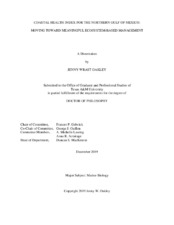| dc.description.abstract | Ecosystem-based management is an integrated approach that recognizes complex interactions within an ecosystem and manages based on multiple aspects of ecosystem health and function, instead of focusing on only single species or sector-based management. This dissertation facilitates ecosystem-based management for the Northern Gulf of Mexico by explicitly defining spatial boundaries and developing a framework for evaluating ecosystem health using robust and diverse resources of monitoring data. Herein, I define nine coastal regions for the Gulf Coast, combining both regulatory and biophysically meaningful spatial boundaries within which ecosystem health was evaluated. I developed a Coastal Health Index (CHI) as a framework for measuring and monitoring coastal health.
The CHI integrates ten variables representing measurable attributes of ecosystem health, including food provisioning, artisanal fishing opportunity, natural products, carbon storage, coastal protection, tourism and recreation, coastal livelihoods and economies, sense of place, clean waters, and biodiversity. To incorporate stakeholder perspectives within the CHI, I surveyed citizens of the Texas Gulf Coast. The survey responses (n = 1,815) provided perceived levels of importance of CHI variables and informed a differential weighting scheme for calculating regional instances of the CHI. A CHI score of 70 out of 100 was calculated for the Gulf Coast as a whole, using the most recent available data as of 2018. The variable that scored the lowest for the Gulf was carbon storage (18) while the coastal livelihoods and economies variable scored the highest (95). CHI scores were heterogeneous among regions and variables. Region F3 (the Apalachicola Cuspate Delta) scored the highest (85), while region F7a (the Upper Texas Barrier Island System) scored the lowest (58). Surveyed Texas stakeholders valued clean waters as the most important variable of the CHI, which is consistent with similar studies world-wide. This information may assist resource managers in aligning environmental-based management actions with public priorities. This initial calculation of a CHI may serve as a benchmark for long term monitoring of coastal ecosystem health, improving the ability to measure impacts from management actions and human and environmental stressors to coastal ecosystems. | en |


